Rainstormin’ Outside? Join us for Some Serious Brainstormin’ Inside
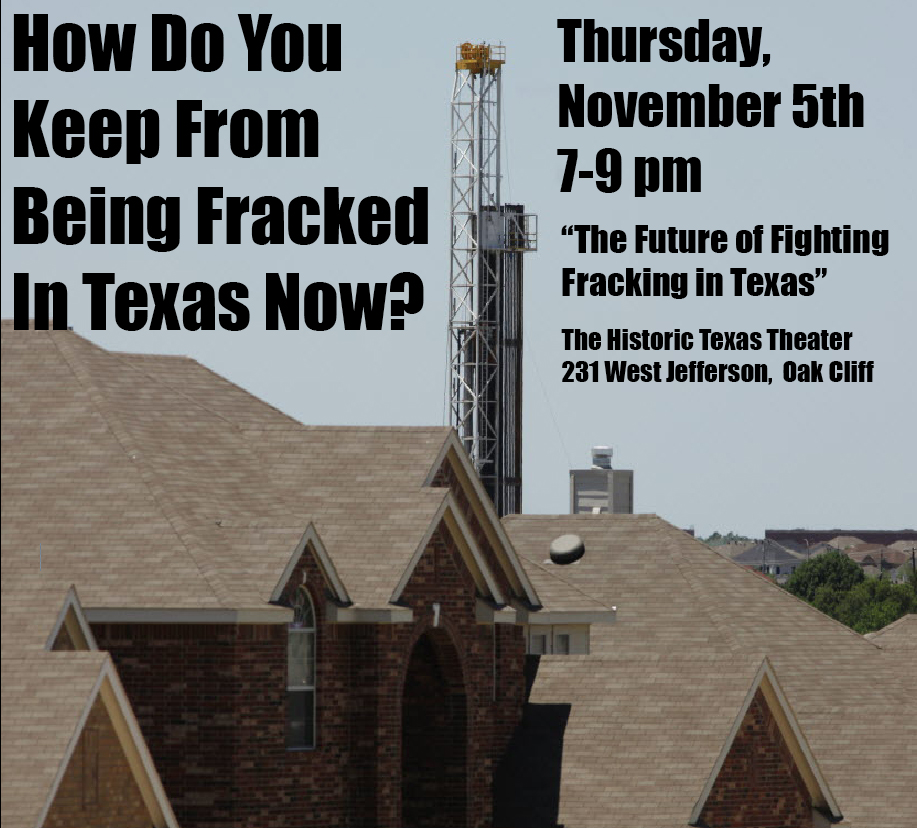
Join us in a public discussion about what happens now that the state legislature has taken away cities' right to regulate fracking.
Listen and Join In. It's a strategy session, not a presentation. We want and need your input.
Panelists include:
Lois Gibbs – Center Center for Health, Environment & Justice and founder of America's anti-toxics movement
Tom "Smitty" Smith – For over 30 years, Smitty has been the "people's lobbyist" in Austin, serving as Director of Public Citizen/Texas
Adam Briggle – UNT Philosophy professor, sometime civil disobedient protester, and a leader of Frack Free Denton
Zac Trahan – Former Dallas Director of the Texas Campaign for the Environment, a key leader in the Dallas Fracking Wars
Ranjana Bhandari – One of the founders of new group Livable Arlington, and working to create a statewide alliance
Marisa Perales – an environmentally-friendly attorney in private practice with Frederick, Perales, Allmon & Rockwell.
Moderated by Tamera Bounds, a founder of Mansfield Gas Well Awareness, and the Texas Grassroots Network.
Don't Miss This Opportunity
to Take Back the Future
7pm to 9pm
The Historic Texas Theater
231 West Jefferson in Oak Cliff
FREE ADMISSION
Tonight’s The Night….

(NW Corner of Lemmon and Central)
TCEQ Makes Sure Friday Really is an Ozone Action Day
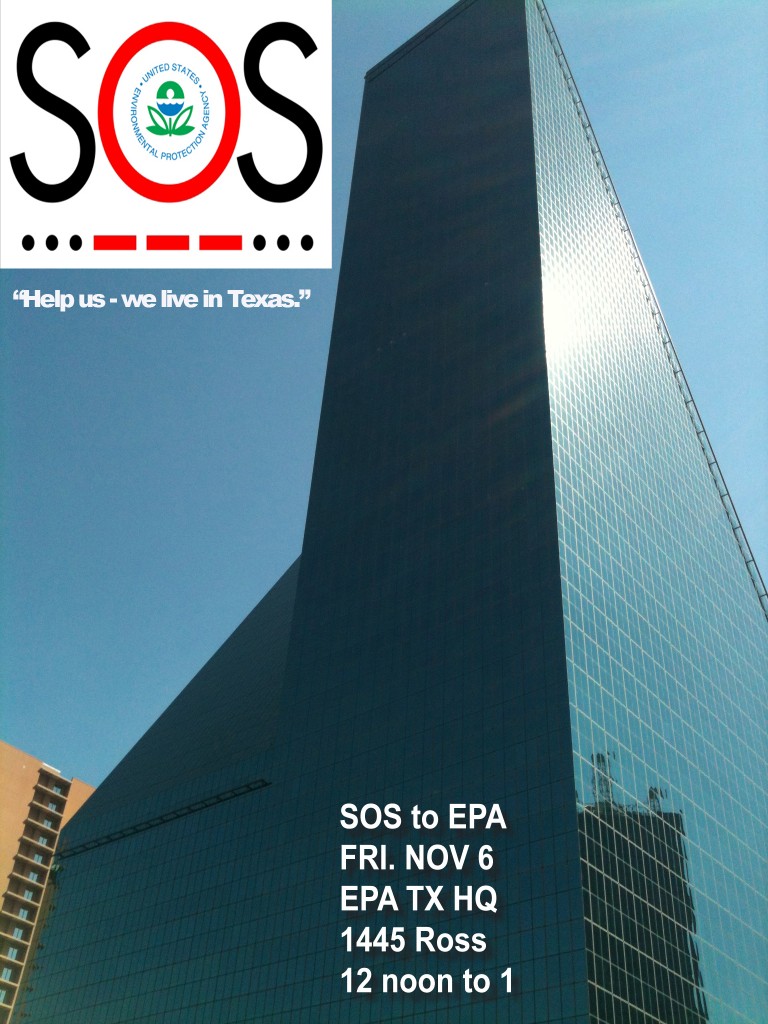
Just like the South attempted to "nullify," or disregard federal civil rights legislation in the 1960's, so Texas is now trying to nullify federal environmental laws.
For that to change, we have to speak-up and demand EPA action. We need a strong federal response to the ridiculous foot-dragging and litigating by Texas
So we're sending a message they can see all the way up on the 12th floor of EPA Regional Headquarters on Ross in the FountainPlace building.
We're constructing a huge "S.O.S." to let the Agency know we need its help to overcome Texas' resistance.
The more people, the bigger the message.
It's another part of Root and Branch 2015
Arlington Conservation Council, Beyond Coal/Texas, Code Pink Greater Dallas, Earthworks, Environment Texas, Dallas Sierra Club, Liveable Arlington, Mansfield Gas Well Awareness, North Texas Light Brigade, Public Citizen/Texas, Texas Campaign for the Environment, Texas Grassroots Network, Veterans for Peace
TCEQ to Reveal 2nd "New" DFW Air Plan in Less than 10 months at Regional Air Quality Meeting This Friday – After our EPA Action
NEW SMOG STUDY BY ITS UNT AUTHORS
1:30 pm THIS FRIDAY NOV. 6th
North Central Texas Council of Government HQ
616 Six Flags Rd
Arlington
SO…FRIDAY REALLY IS OZONE ACTION DAY
12 NOON to 1
Join us in downtown Dallas to urge EPA to take a tough stand with Texas
in protecting our air and water
1:30 – 3:00
Then caravan over to Arlington and get a whole new set of reasons why we need that federal help.
Help us show EPA – AND AUSTIN – there's a demand for cleaner air and water in Texas.
First Public Strategy Session for Texas “Fractivists” Since State Legislature Stripped Cities of Zoning Authority
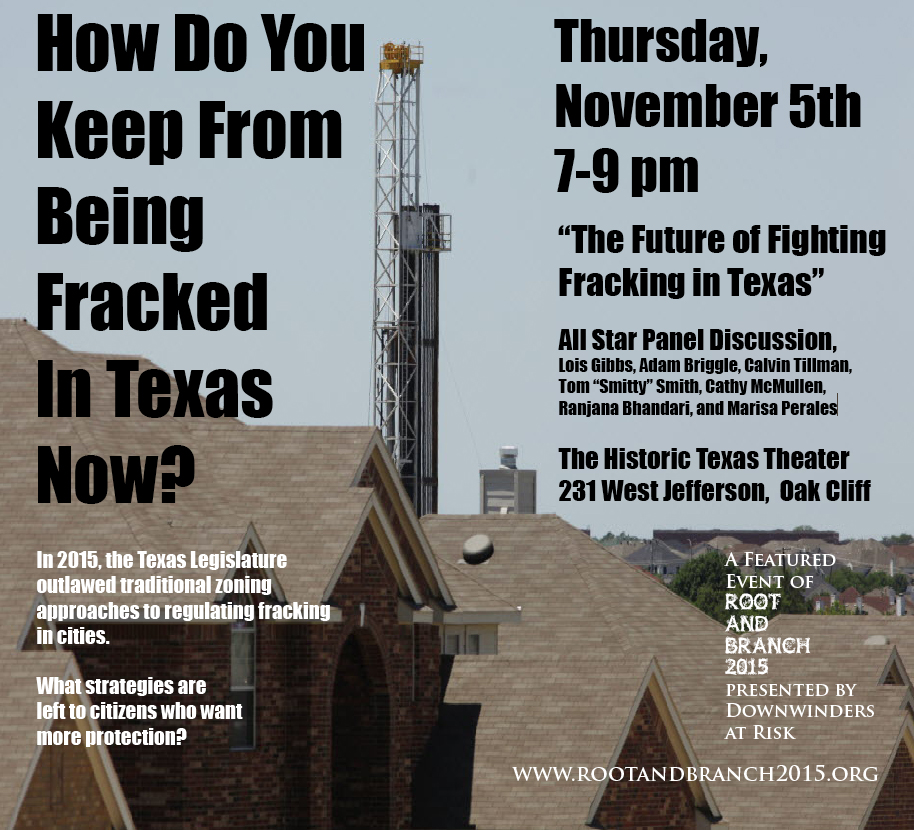 What: “The Future of Fighting Fracking in Texas”
What: “The Future of Fighting Fracking in Texas”
When: 7-9 pm Thursday, November 5th
Where: Historic Texas Theater in Oak Cliff, 231 West Jefferson
Who: Regional and Statewide Activists, Attorneys and Organizers
(Dallas)— A new alliance of groups fighting for more protective fracking regulation in Texas is using a Dallas environmental conference to host the first statewide strategy session responding to the passage of HB40 by this year’s state legislature.
Dubbing itself the “Texas Grassroots Network,” organizers include key members of local groups in Arlington, Denton, and Mansfield. Since their first meeting during the summer, they’ve also received calls from South Texas residents who live in the Eagle Ford gas and oil field. Their aim is to create something Texas has never had – a statewide coalition of grassroots groups tackling the same industry and the same problems caused by that industry setting up shop too close to people.
On the evening of Thursday, November 5th, they’re taking over Dallas’ historic Texas Theater to begin what they say will be a wide-ranging and free wheeling discussion about what the best options for those who don’t want to live side-by-side with drilling rigs in light of the legislature’s restrictions on local zoning.
“It’s time to regroup and come up new ideas and strategies about how to stop irresponsible fracking,” said Tamera Bounds, of Mansfield Gas Well Awareness. “We need to use our anger of what the legislature did to fuel new efforts and recruit new supporters. Most Texans want local control of fracking. Our job is to build a statewide movement reflecting that.”
“The Future of Fighting Fracking in Texas” is the second featured event of local clean air group’s Downwinders at Risk’s four-day floating conference, called “The Root and Branch Revue.” Other conference events include an evening of “environmental comedy” with Bar Politics, a day of workshops aimed at sharpening activist skills, and an attempt to construct “the world’s largest S.O.S” outside EPA Regional Headquarters in downtown Dallas. Lois Gibbs, of Love Canal fame, is the featured guest.
But it’s Thursday’s panel discussion and a follow-up on Saturday that could potentially have the biggest impact on the Texas environmental movement. Many opponents of urban fracking are still reeling from the state’s ban on local zoning restrictions last spring. There hasn’t yet been a coordinated or articulated response. Organizers of the Texas Theater discussion aim to fix that.
Participating will be some of the most high-profile regional fractivists, including Bounds, who’ll moderate, Adam Briggle and Cathy McMullen from Denton, Ranjana Bhandari form Arlington, and former DISH mayor Calvin Tillman. Joining them onstage on stage will be Public Citizen/Texas staffer Tom “Smitty” Smith, Austin-based environmental attorney Marisa Perales, and Lois Gibbs herself.
“HB 40 has forced us to look beyond our own city limits and find new ways to organize residents,” said Bounds. This public strategy session is one of he first steps we need to do that and regain momentum.”
Pair of Unprecedented Studies Challenges Texas’ Official Indifference to DFW Smog
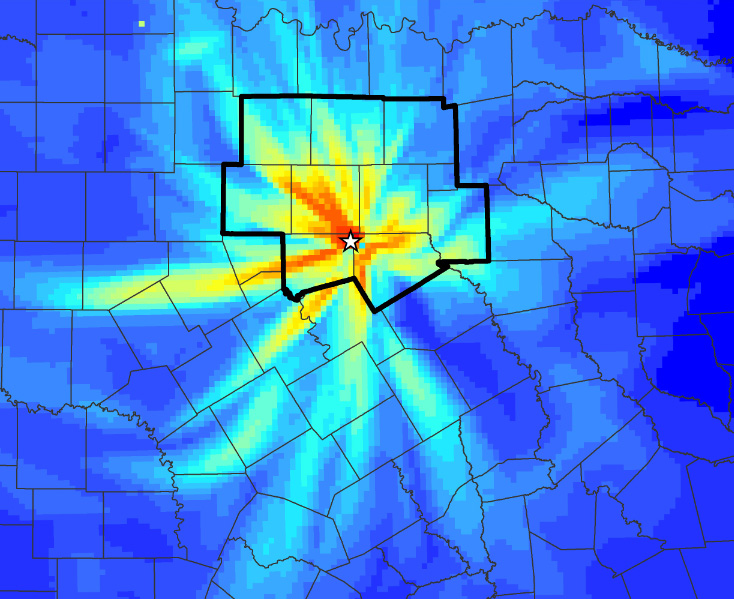 (Dallas)—- Two first-of-their-kind studies on Dallas-Fort Worth smog, released in tandem today, challenge the State’s assertions that dirty air has little public health impact on local residents, and new controls on major polluters won’t make a difference.
(Dallas)—- Two first-of-their-kind studies on Dallas-Fort Worth smog, released in tandem today, challenge the State’s assertions that dirty air has little public health impact on local residents, and new controls on major polluters won’t make a difference.
Using the school’s banks of supercomputers, engineers at the University of North Texas replicated the massive computer model being used by the Texas Commission on Environmental Quality to write the region’s new clean air plan. They then used the model to test the effects on local ozone when pollution levels were reduced from aging coal plants in East and Southeast Texas, the three cement plants in Midlothian, and oil and gas facilities in the Barnett Shale and elsewhere – tests the state agency had not done on its own model in almost a decade.
They found such reductions, mimicking the effects of modern pollution controls, would propel North Texas into compliance with the current smog standard and decrease smog significantly around the region. It’s the first time anyone outside of Austin or the TCEQ has had access or control over a region’s “non-attainment “ modeling.
in today's Dallas Morning News.
Accompanying the release of the UNT work was another unprecedented effort by Dr. Robert Haley of the Texas Medical Society using EPA “benefit mapping” software to estimate public health benefits of cutting smog levels by at least five parts per billion. Complying with the current standard in DFW would require a decrease of more than 8 parts per billion from 2015 levels.
Haley found a five part per billion decrease would have large medical and economic consequences, including preventing over 75 deaths, 350 Emergency Room Visits, 160 hospital admissions, and 120,000 lost school days in the 10-county DFW nonattainment area annually, totaling over half a billion dollars in medical care costs and lost productivity.
“Together, these studies provide a powerful rebuke to the state’s inaction on dirty air in DFW,” said Jim Schermbeck, Director of Downwinders at Risk, the 21-year old clean air group that financed the UNT effort. “Using the data from these two studies, it’s clear reducing pollution from these major sources, especially the coal plants, would have a large and beneficial impact on North Texas public health, and save the local economy millions of dollars.“
Frustrated by over two decades of official state modeling that has predicted success but delivered five failed air plans in a row, Schermbeck said his group wanted a second opinion going into a new round of planning, as well as an opportunity to look at different control strategies TCEQ refused to examine.
In the past, such an undertaking would have cost millions. But the price of computing has come down to such an extent that even huge, complicated tasks like modeling the DFW airshed can be performed for a fraction of what they once cost.
Downwinders wrote grants for the project and assembled $120,000 in financing from local DFW sources including the Harold Simmons Foundation, Trammell S. Crow, Garrett Boone and the Dallas Foundation.
Dr. Kuruvilla John, Associate Dean of Research and Graduate Studies, Professor of Mechanical and Energy Engineering, College of Engineering at UNT, was chosen because of his accessibility, lower transportation costs, and past collaborations with the TCEQ. Dr. John reported to a committee of current and former officials, chaired by former Dallas County Judge Margaret Keliher, and including Dallas County Commissioner Theresa Daniel and Dallas City Councilwoman Sandy Greyson.
Schermbeck noted Dr. John built a duplicate of the Texas Commission on Environmental Quality’s computer model used to design a new DFW clean air plan. All the variables used in the model are the state's, including the meteorology and the projected emissions of pollution from all categories of sources. None of the information used in the model originated with Downwinders at Risk or the UNT engineers. In fact Dr. John benefited from TCEQ’s technical assistance in completing his duplicate and previewed the results to TCEQ officials in September.
In all, UNT ran at least 15 different scenarios through the TCEQ model that examined the impacts of reductions of smog-forming pollution from individual sources, as well as combinations of reductions. Among the most significant findings:
- Without a doubt, the single largest industrial source of DFW smog is the pollution from antiquated coal-fired power plants in East and Southeast Texas. If you want to have a quick and dramatic reduction in DFW ozone levels, installing modern controls on these coal plants would be the first step.
- Conversion of the Midlothian cement plants from dirtier wet kilns to cleaner dry kilns over the last decade has improved air quality, but they remain sizable polluters. Adding modern controls could significantly decrease downwind smog, particularly in Tarrant and Johnson Counties.
- Decreases in regional smog from reductions in pollution from oil and gas sources skew lower since those sources are primarily located in the five western-most, downwind counties of the DFW non-attainment area. Even so, reductions in pollution from oil and gas have disproportionally higher impacts because they affect many of the historically worst performing air quality monitors.
- The most effective combination of control measures studied were: 1) reducing smog-forming Nitrogen Oxide (NOx) pollution by 90% or more at the coal plants, 2) reducing NOx by 90% at the cement plants, and, 3) electrification of all large gas compressors, or a 100% reduction in NOx from those sources. This combination brings down smog levels at all 20 DFW monitors an average of 5 parts per billion (ppb) and lowers the regional average to below 75 parts per billion – the current smog standard DFW has yet to meet.
- UNT’s results have already answered many of the questions the EPA posed to the state in its official comments concerning the proposed Dallas-Fort Worth air plan earlier this year, including,
“How would a reduction in NOx emissions from utility electric generators in just the counties closest to the eastern and southern boundaries of the DFW area impact the DFW area?”
As has been noted, UNT found reductions in smog-forming pollution from these coal plants have a profound impact on DFW smog levels. UNT’s study now becomes a source of information about the state’s plan for the EPA when the state itself can’t, or won’t, provide it
6. The results of this study directly contradict statements made in the Texas Commission on Environmental Quality’s most recent DFW air plan. For example,
"…the impact of the suggested NOX controls on East Texas EGUs is not expected to have a substantive impact on Denton Airport South monitor in the DFW area.”
In fact, UNT’s results show removing 90% of the coal plants’ NOx would reduce ozone by as much as 4. 5 parts per billion at the Denton monitor and bring the monitor’s annual average down below the current required standard of 75 ppb.
DFW has been in continual violation of the Clean Air Act for almost 25 years because of its chronic smog problem. Despite state and industry claims that air quality is getting substantially better, progress has stagnated over the past five years. In 2010, the regional smog average was 86 ppb. Today, it’s 83.
DFW is one of only four non-California metropolitan areas the EPA estimates will still not be in compliance with the current 75 ppb standard by a deadline of 2018. It’s also one of only about 10 metropolitan areas not expected by EPA to meet the brand new proposed standard of 70 ppb by 2025.
Critics of the state, such as Schermbeck, note this lack of progress corresponds to anemic air plans proposed by Austin, which never include new controls on any major polluters. Schermbeck says the UNT study provides a technical justification for now including those controls, if not to the state, which he discounts as an “unserious participant,” at least to the EPA and local officials. It’s this unprecedented breaking-up of the state’s monopoly on the technical expertise upon which the entire local air quality planning process relies that Schermbeck thinks is as important as the results themselves.
“Up to now, if the state didn’t want to look at a control measure, it didn’t get looked at,” said Schermbeck. “If the state said a new technology wouldn’t do any good, you just had to take their word for it. But if a local grassroots group can scrape-up enough funding to provide a viable alternative, there’s no excuse for DFW officials to be completely dependent on the state anymore.”
Downwinders and other clean air advocates are already using both studies to argue on behalf of a Dallas County Commissioners Court resolution coming up for a vote this Tuesday, October 20th. Sponsored by Commissioner Daniel, it urges the judge hearing the EFH bankruptcy case to require modern controls on Luminant’s three East Texas coal plants as a condition of their sale.
Schermbeck also predicted the UNT study would have a very large impact on how the current DFW air plan would be drafted, and even its chances of being approved by EPA. “UNT’s use of TCEQ’s own model to quantify the effects of off-the-shelf control technologies provides answers to questions EPA already had about the plan, but which TCEQ seems reluctant to respond. Because there’s another set of hands on the model that can produce those answers, TCEQ has significantly less wiggle room to rationalize why they aren’t requiring the controls their own data shows are effective at reducing smog.”
It’s also likely the UNT results will be used in an effort to tie the East Texas coal plants to the fate of the DFW nonattainment area under the new 70 ppb ozone standard. “It’s unfair and bad public policy for those plants to have such a huge impact on our air quality but be untouched by our area’s anti-pollution measures,” said Schermbeck, whose group successfully petitioned the EPA to bring Ellis County and the Midlothian cement plants into the DFW nonattainment area over a decade ago.
Schermbeck looks at both studies as evidence of a trend toward greater democratization in policy-making because of grassroots access to heretofore prohibitive resources. “Both of these studies show the ability of new technology to empower groups that were previously at the mercy of Big Government or Big Industry. When citizens have new tools, things change.”
More Information on the UNT study can be found at: www.dfwozone study.org.
DFW One of Only Ten Areas Nationwide Not Expected to Meet New Smog Standard by 2025
 There was a lot of coverage of last week's announcment of a new, more protective national smog standard by EPA. Most of it centered on the reaction by both sides that it was either not enough progress (public health advocates), or Western Civilization was about to collapse under the weight of all the controls necessary to meet the standard (National Chamber of Commerce, et al.).
There was a lot of coverage of last week's announcment of a new, more protective national smog standard by EPA. Most of it centered on the reaction by both sides that it was either not enough progress (public health advocates), or Western Civilization was about to collapse under the weight of all the controls necessary to meet the standard (National Chamber of Commerce, et al.).
But if you read deeper into the articles, many of them mentioned computer modeling EPA had already done that demonstrated, given current trends, only 14 counties, representing 10 separate areas, wouldn't be able to meet the new standard by the target year of 2025. Unfortutantely, none of those articles mentioned which 14 counties, or which 10 areas.
Now, given all that you already know about our state and regional track record for meeting clean air deadlines, your first question might be: how many of those are in Texas? We'll give you a minute or two to start a pool and pick a number….
And the answer is: Three. Brazoria and Harris Counties in the Houston "non-attainment area" for smog, and Tarrant in DFW's non-attainment area. (The ten areas are: Baltimore, Dallas-Fort Worth, Denver, Fort Collins, Houston, Louisville, Milwaukee, New Haven, New York, and Pittsburgh).
Of course, for the purposes of regional smog record-keeping, EPA doesn't separate Tarrant County numbers from Dallas County, or Denton County, or any of the other nine counties in the non-attainment area. If one monitor is out of compliance in the area, the whole region is considered in violation. So EPA is conceeding that both DFW and Houston will still continue to be in continual violation of the Clean Air Act for another decade.
This is discouraging but not surprising. The State refuses to put new-generation controls on large major polluters like the Midlothian cement plants, East Texas coal plants, and gas production facilities, while painting the rosiest scenarios with its own modeling.
But this new revelation means it's that much more important to get EPA to override the state and act now to include controls on those major polluters, while the current smog plan is in the pipeline. It may be the only chance we have in the next 5-10 years to adequately address these sources. This can only be done if the EPA decides to revoke Texas' authority to write and implement these plans – to commit to a Federal Implementation Plan of its own.
PLEASE….
1) Sign our Change.Org petition urging the EPA to reject the state's clean air plan for DFW and substitute one of its own, and
2) Send an e-mail to the Chief EPA administrator in Washington and the Regional Administrator here in Dallas saying you want them to take responsibility for a new DFW air plan.
Thanks.
EPA Lowers New Ozone Standard for Rest of the Country from 75 to 70 ppb. Texas? Not so Much.
 (Dallas)—Although they’re happy the Obama Administration is finally following its own scientists’ advice in lowering the national smog standard, local clean air activists say it won’t do North Texas residents much good as long as the state is charged with meeting it.
(Dallas)—Although they’re happy the Obama Administration is finally following its own scientists’ advice in lowering the national smog standard, local clean air activists say it won’t do North Texas residents much good as long as the state is charged with meeting it.
“When you have a state government that doesn’t believe smog is even a health problem, you’re not going to get effective enforcement of smog standards,” warned Jim Schermbeck, Director of Downwinders at Risk, the two-decade old local clean air group.
EPA officials have scheduled a Thursday afternoon briefing to announce the Agency is lowering the smog standard from the current 75 parts per billion (ppb) to 70 ppb. Although that doesn’t seem like a large change, it’s enough to prevent an additional 325,000 cases of childhood asthma and 1,440 premature deaths every year according to EPA estimates. But those numbers assume nationwide attainment of the standard. Lungs of Texas residents are routinely denied equal protection under the Clean Air Act by a state government that over 20 years has never drafted a successful smog clean-up plan for two of the most chronically-polluted metro areas in the country.
Until only a year ago, DFW was struggling just to meet the obsolete 1997 smog standard. After a mild summer in 2014, smog actually got worse this past summer, with the regional average going up. DFW officially has the worst air in the state, with a higher smog average and more monitors out of compliance. Air quality progress is stagnating. In 2010, the regional average was at 86 ppb. Today, it’s at 83.
“Texas just isn’t serious about doing what it takes to get cleaner air,” said Tamera Bounds of Mansfield Gas Well Awareness. “That’s why we need the EPA to take over the job of writing these plans so they stand a chance of actually working.”
Bounds referred to the state’s proposed clean air plan for getting to the current 75 ppb smog standard as nothing but watching a new federal gasoline mix be implemented and piggybacking its impacts. It requires no reductions from any major pollution sources. “They know it’s not going to work, and they don’t care.”
Schermbeck said Texas residents can expect more of the same when it comes to meeting a lower, more protective smog standard of 70 ppb. “If they weren’t concerned about meeting a standard of 85 or 75 in a timely way, it’s hard to imagine they’ll suddenly get religion for one at 70 ppb,” said Schermbeck, “…especially when they’re fighting it in court.”
Although EPA has final approval over any such plan, it’s usually left up to the states to draft them. Downwinders is sponsoring a campaign urging EPA to assume responsibility for writing a new clean air plan for DFW itself. Such a rebuke to a state is rare, but it’s an option under the Clean Air Act. “Breathers in North Texas who need cleaner air don’t have any confidence the state can, or even wants to do the job,” sighed Bounds. “Our only hope is EPA.”
US Cement Plant Using SCR Pollution Control Device Achieves 80% Reduction. Texas Says It’s Still Not Feasible.
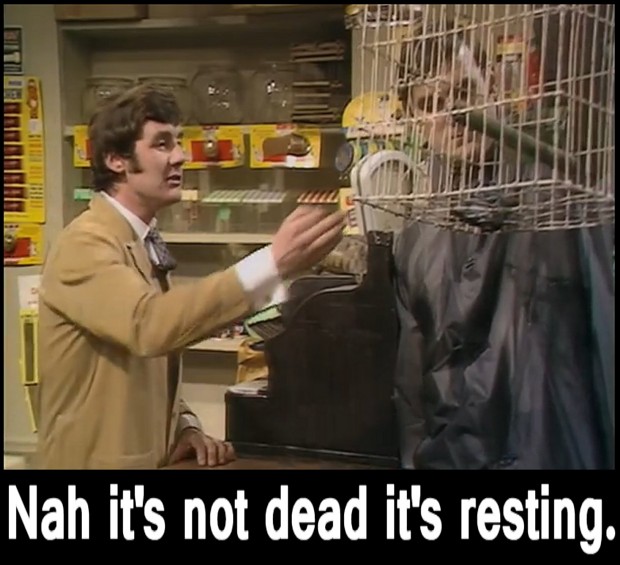 EPA has released the results of the first test of a full-scale Selective Catalytic Reduction (SCR) unit on a US cement plant and the numbers look good.
EPA has released the results of the first test of a full-scale Selective Catalytic Reduction (SCR) unit on a US cement plant and the numbers look good.
As many of you know, SCR is just an industrial-sized version of the catalytic converter in your car. It can capture up to 90% or more of the smog-forming pollution from a cement plant. In use on cement kilns since 2001, there are at least a half a dozen cement plants in Europe that use SCR successfully, but the technology has been slow to arrive in the US because of regulatory laziness and industry resistance.
But after 15 years, that's finally changing.
in 2013, LaFarge Cement entered into a consent decree with the EPA and the US Justice Department as part of a settlement over a string of environmental violations, including excessive smog-forming Nitrogen Oxide (NOX) emissions. As part of that settlement, Lafarge was to retrofit its Joppa, Illinois "dry process" cement kiln with an SCR unit, record its effectiveness during stack testing, and report on the results of those tests by 2015.
This last week, those results were finally made available by EPA and they show SCR was able to reduce NOx by 80%.
That's approximately twice as effective as SNCR technology, (Selective NON-Catalytic Reduction), the current pollution control device for NOx most often used in U.S. cement plants.
Moreover, according to LaFarge, "the SCR control technology performed well and no operational problem was encountered."
In fact, the control technology worked so well, LaFarge is now getting a permit from the Illinois state environmental agency to operate SCR past the EPA-mandated settlement period.
But while LaFarge is getting its SCR permit, Holcim's Midlothian cement plant has already applied and been granted one by the Texas Commission on Environmental Quality for construction and operation of its own SCR unit. It should be up and running by this time next year.
So that makes two U.S. cement plants with permits to run full-scale SCR units. One that was forced into the choice by EPA and now wants to keep using it, and another voluntarily adding it.
But according to the TCEQ, even though it gave a permit to Holcim to install SCR, and even though Holcim's SCR unit will be operational in a year, and even though the LaFarge test was a success, and even though SCR has been used for 15 years by European cement companies – SCR is "not economically or technically feasible." That's exactly what the Commission said in response to comments from both citizens and the EPA in its new clean air plan for DFW a couple of months ago.
That's right. One the one hand the Commission has granted a permit to Holcim to build an SCR unit in its own backyard, and on the other it's still calling the technology infeasible. It's the stuff of Monty Python sketches.
And that's not all. There is no mention of the Holcim Cement SCR permit in the TCEQ's own official arguments against SCR in its DFW clean air plan. Not one. Since Holcim's building of an SCR unit would tend to empirically disprove TCEQ's contention that the technology wasn't practical, the state just pretends it's not happening. As with climate change and smog, any facts that conflict with the pre-determined ideologically-correct premise must be ignored.
Presumably, Holcim is building the SCR unit because it's made the business judgment that the technology is not only both economically and technologically feasible, but beneficial to the company's bottom line. Presumably LaFarge is pursuing a permit for its SCR unit because it has made the same practical decision. Yet, in a strange role reversal, a Texas state government agency is now telling business it's making the wrong choices. It's overruling the industry's decision to reduce pollution through SCR use by saying "not so fast."
This is how bad its gotten: the Texas approach to clean air is now so backwards that the cement industry is more aggressive about reducing pollution than Austin.
So how many U.S. cement plants have to be operating with SCR before the State of Texas concludes it's a feasible technology? Two? Four? A Dozen?
Fortunately, the TCEQ isn't the last word on this. The Clean Air Act says any and all reasonably available technology must be used on major pollution sources like the Midlothian cement plants when a clean air plan is being drafted. TCEQ hasn't done that. We think they're breaking the law. There are signs that EPA thinks so as well.
EPA is ultimately in charge of enforcing the Clean Air Act, and if it doesn't do it correctly, then the courts step in.
The best hope for safe and legal air in DFW is for EPA to rigorously enforce the law. The State of Texas will not do so. If you agree then please take a minute to:
1) sign this petition to EPA
2) Send this e-mail to EPA
Thanks.
THANKS SO MUCH
 Our gratitude and sincere thanks to everyone who contributed money to Downwinders during yesterday's Giving Day marathon/assault. We came within $500 of reaching our goal of $7500. That's the closest we've ever come to breaking that ceiling. Stay tuned for more details about our Root and Branch grassroots conference and the debut of our large air quality modeling project at the end of the month
Our gratitude and sincere thanks to everyone who contributed money to Downwinders during yesterday's Giving Day marathon/assault. We came within $500 of reaching our goal of $7500. That's the closest we've ever come to breaking that ceiling. Stay tuned for more details about our Root and Branch grassroots conference and the debut of our large air quality modeling project at the end of the month
Late Night Smog Special: 2 Hours Left To Support Cleaner Air in DFW
 Smog got worse this year. The three-year rolling average EPA uses to keep track of dirty air went up twice in two days.
Smog got worse this year. The three-year rolling average EPA uses to keep track of dirty air went up twice in two days.
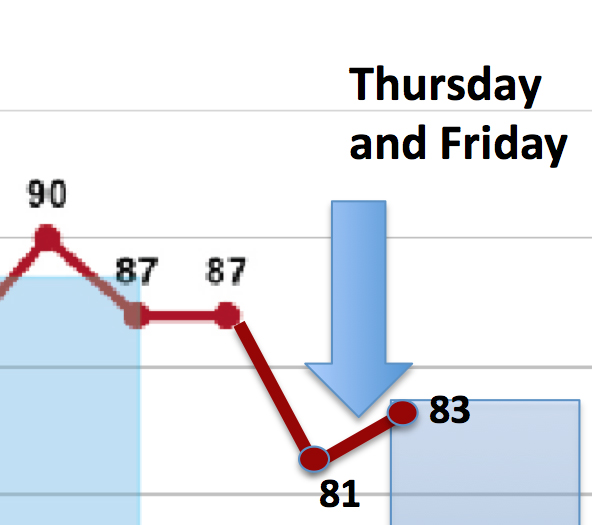 It went up even though the state's second "do-nothing" air plan kicked-in THIS summer. That's right. The first ozone season the state's plan is supposed to make better is one that saw smog levels rise. Who could have predicted?
It went up even though the state's second "do-nothing" air plan kicked-in THIS summer. That's right. The first ozone season the state's plan is supposed to make better is one that saw smog levels rise. Who could have predicted?
Downwinders could.
We've been fighting this second "do-nothing" air plan from Austin for over 16 months now. We've been challenging its numbers. We've been questioning its application of the law. And we said there was no way it could work. Earlier this year, the EPA went on record agreeing with many of our arguments. Approval from DC is now at least in doubt.
Downwinders at Risk is the only group that makes it a priority to monitor and participate in the decision-making surrounding DFW air quality. We've used it to modernize the cement industry. We're using it again to modernize the East Texas Coal Plants, oil and gas operations, and yes, the cement plants one more time.
We're only $600 – $700 away from reaching our Giving Day goal of $7500 by Midnight. Reaching it means we can fully fund our first-ever grassroots citizens conference. Your contribution of $25 goes further in the next couple of hours than it will after the clock strikes Twelve.
If you've already donated, thanks very much. If you haven't, please consider helping us out. Not because we do good work but because it's in your own self-interest to have us out there fighting for your lungs. Thanks.

